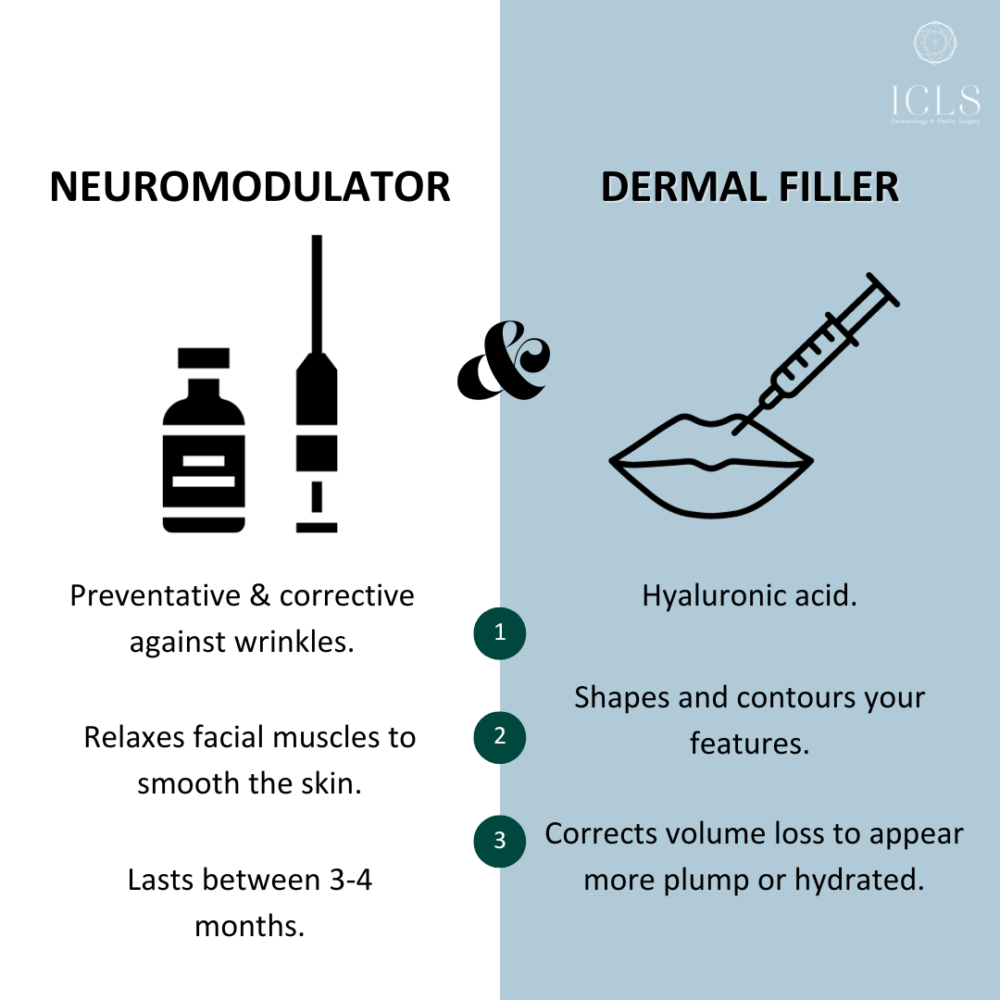
When it comes to cosmetic procedures, having the right information is crucial for making the best choices for you, ensuring great results with minimal risks.
For example, when you are considering face fillers and Botox, (a neuromodulator), it is important to take into account your specific aesthetic goals and the areas you want to address. Understanding the differences between these procedures is key, even if you’re considering a combination treatment.
At ICLS, serving Oakville and the GTA, Ontario, we strive to make you look and feel your best on your own terms – we don’t attempt to define what beauty means for you. We are empowering the best version of you, while still having a very natural look.
This blog post will break down the differences between the injectables – face fillers and Botox.
Face Fillers and Botox: How They Work
Face fillers are designed for injection into the skin to restore lost volume, resulting in a more rejuvenated appearance.
Face fillers can help achieve more volume and balance in our face. They can also help contour and shape lips, cheeks, temples, chin, and jawline to accomplish a more desirable look and can also help reduce the look of acne scars.
Some face fillers can be used to help hydrate our skin for a healthier appearance and glow and can even be used to help stimulate collagen and soften the look of lines and sagginess on the neck, chest, knees, and arms.
Since they are compatible with our body’s biology, they are easily tolerated with minimal risk of causing adverse reactions.
Common face fillers are:
- Juvéderm
- Belotero
- Teosyal
- Radiesse
- Sculptra
On the other hand, similar to Kleenex for a box of tissues, Botox is a household name for a specific neuromodulator. Other neuromodulators we carry are:
Neuromodulators are an injectable medication containing botulinum toxin. They work by weakening the signal that is passed between the brain and the muscle, relaxing overly strong facial expressions that cause dynamic wrinkles. As the pull of the muscle relaxes, the overlying skin ultimately appears smoother; the result is a brighter, more awake and more youthful-looking facial aesthetic.
But beyond wrinkle control, neuromodulators can help to control oil production and pore size, help to soften and slim the jawline, create a “lip flip” or slight brow lift, help relieve tension in specific muscle groups, and even treat migraines.
Face Fillers and Botox: How They Are Different

Differences between neuromodulators and fillers
To simplify, let’s break down these differences into the following:
- How they work
- Where they are used
- Side effects
- How long the effects last
- How much the treatment costs
-
How they work
The main difference in how Botox and face fillers operate is in what they target.
Botox, a neurotoxin, works by temporarily and safely weakening nerve signals that prompt muscle contractions, leading to muscle relaxation.
On the flip side, face fillers are injectable substances crafted to add volume beneath the skin’s surface. They physically fill in spaces, offering support and plumping up the skin.
-
Where they are used
Though the areas of treatment may overlap, Botox is usually applied to specific facial zones like the forehead, frown lines between the eyebrows, and the corners of the eyes (crow’s feet). It can also be used on the masseter muscle to alleviate jaw pain and teeth grinding.
In contrast, face fillers reach into softer facial tissues, including the lips, as well as the neck and décolletage.
-
Side effects
Once again, they share common side effects like redness at the site, mild swelling, and pain. These are temporary and will go away quickly.
However, the differences stem from their distinct mechanisms of action. Since Botox targets muscle activity, there’s a rare and temporary risk of adverse effects such as muscle weakness or drooping in the treated area.
In contrast, face fillers are injected substances, and undesired effects could arise from introducing a foreign substance into the body, especially if there’s a known allergen.
In any case, it’s crucial to promptly inform your treatment provider of any side effects.
This is why at ICLS, we ensure you receive your injections only from qualified, board-certified injectors who work to help achieve your desired results.
-
How long the effects last
This varies amongst individuals, especially due to factors such as adherence to post-treatment instructions, baseline skin needs, and specific treated areas.
Depending on the area treatment, face fillers can last anywhere from 6 to 12 months. Areas with higher movement, such as lips and expression lines, require more frequent treatment. Areas that are more stable/structural, such as cheeks or temples, may last longer. In addition, certain injectables – such as Sculptra® and Radiesse® — are known to last much longer, sometimes up to 2 years.
For neuromodulators, on average, results last from 3 – 4 months, depending on various factors, including dosing, metabolism, activity levels, stress levels, etc. It’s expected to have some movement return about two months after treatment and full movement around 3 – 4 months, which is why we recommend re-treating.
-
How much the treatment costs
Botox is charged per unit, and the required units can vary based on the treatment area and individual goals.
Facial fillers are priced per syringe, and the quantity needed is decided by the desired enhancement extent. It also depends on the specific type of filler.
You can opt for our financing options.
Face Fillers and Botox: How They Can Be Combined
Pairing Botox with face fillers works well.
For instance, Botox deals with wrinkles from muscle movements (like crow’s feet and frown lines), while face fillers target static wrinkles (like laugh lines and marionette lines).
Also, this combo cuts down sessions, meaning less time at the clinic and a quicker recovery. It lets you go back to your regular routine without long breaks.
In short, this combination results in a balanced and harmonious appearance.
Begin your journey at ICLS
Although they have their differences, face fillers and Botox can collaborate towards a common aim: rejuvenating your face.
Here’s an extra tip from our experts:
“The benefits of injectable treatments as a preventive measure in your anti-aging plan are that as you age, we can slow down the facial aging process — by helping to reduce muscle movements with neuromodulators and helping maintain structure with fillers.”
Whether you’re ready to get started with either Botox or face fillers (or even as a treatment combo), or if you need more clarification, you can book a consultation with us.
Get in touch today, and we can talk about choices for a more confident and refreshed version of yourself.
